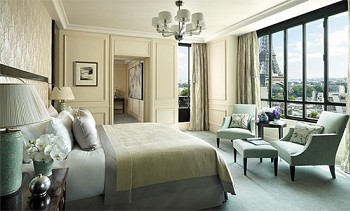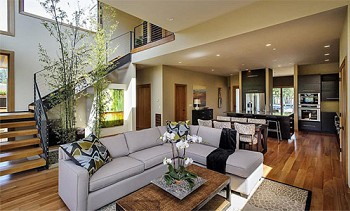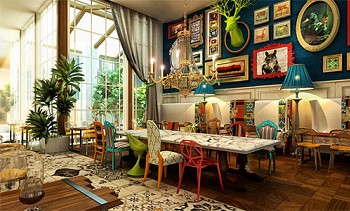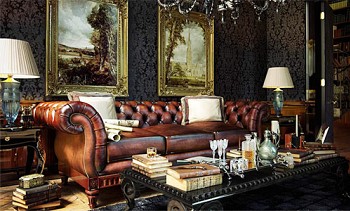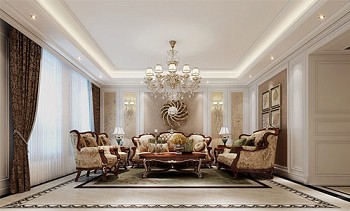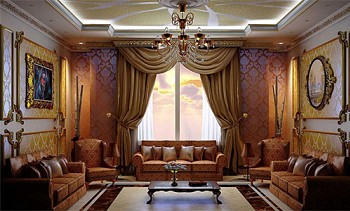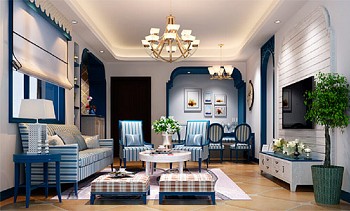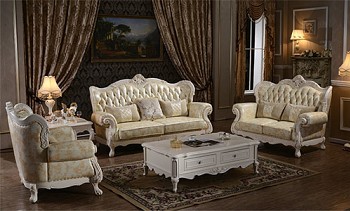Fusion replaced the strict interior styles, dictating strict rules for the organization of premises. It has become a worthy replacement for the modest, almost ascetic minimalism and the functionally impossible constructivism. The fusion style in the interior is the exact opposite. It allows you to go beyond the generally accepted framework, gives you the opportunity to express yourself creatively, to experiment with textures, materials, decor. The peculiarity of the style is a combination of incongruous, courage of ideas and the novelty of their embodiment. At the same time, interior design in fusion style looks stylish and tasteful.
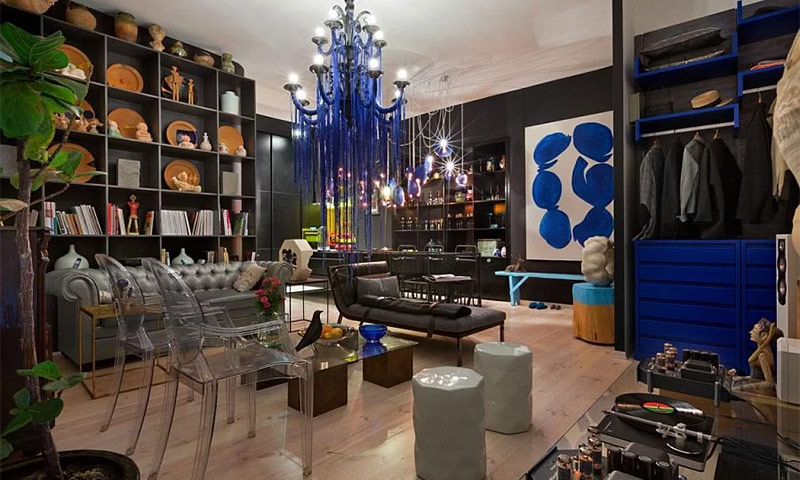
Content:
Style History
The appearance of fusion dates from the years 1970 - 1990. It manifested itself not only in the interior, but also in other areas:
- In music (in 1970 various directions of jazz music with interweaving of ethnic motifs appeared);
- In dance (dance aesthetics became more open and plastic, fusion dances could combine movements of folk, oriental and modern choreography);
- In cinematography;
- In cooking (seasonings and spices unusual for them are added to traditional dishes, they are served in a new artistic manner);
Style rapidly penetrated into various spheres of human activity, gaining more and more fans. Everything traditional was served with a different sauce, presented from a new point of view, uniting continents and nationalities. If fusion music arose in the 70s, then the style got into the interior at the end of the twentieth century. Materials, decor from exotic countries penetrated the traditional interiors, giving them a spirit of freedom, an open-minded openness to everything new.
The first fusion style in the interior was mastered by American designers. They created bold interiors, combining classics with ethnic motifs or baroque with hi-tech. At the same time, they filled the space with decor with Latin American, Chinese or African motifs. So, a soft armchair with patterned fabric upholstery began to side by side with an unusual table with a mirror tabletop and a rug in the form of a leopard skin, zebra or simply with a geometric pattern.
In the 90s of the twentieth century, the concept of "fusion style in the interior" began to sound more and more often. What it is? Translated from English fusion means fusion, alloy, synthesis. This definition began to be applied to interiors in which the incompatible is combined. That is, in the interiors of houses, cafes, hotels, designers increasingly mixed signs of different styles, complementing them with decor and furniture of different nationalities.
For example, the classic bedroom interior with a comfortable bed, white walls and ceiling, classic curtains complemented with color spots typical of pop art, a futuristic chandelier and an Egyptian bust. Completely incompatible at first glance, furnishings, acquired a new meaning in a successful neighborhood with each other. They became an integral part of a single space.
Colors used
Designers today turn to fusion style with enviable constancy. Indeed, the fusion style in the interior of the apartment helps to create a unique bohemian space, which is characterized by simplicity and complex piling of textures, colors and materials.Fusion easily combines these incompatible concepts. The combination of colors and patterns sets the tone for the entire interior. Although at first glance there is no logic and at least some regularity in the fusion color scheme, this is not so. The color palette is carefully selected, while creating the impression of complete chaos.
Background colors
Most often, the following colors are used as background in the design of premises:

White.

Gray.

Brown.
These colors can be used each on its own or three colors at a time. With their help draw up the ceiling, walls and floor.
Bright accents
Pure plain colors as well as patterned motifs or paintings are used as color accents. Bright color spots against the background of a gray or brown wall look life-affirming and fresh.
Most often used are:

Orange.

Blue.

Violet.

Blue.

Pink.

Red.

Green.

Light green.

Yellow.
Characteristic patterns for fusion style
Interior design in fusion style is characterized by an abundance of various patterns. They quietly get along next to each other, creating a unique creative space. To emphasize the individuality of the interior, its character and freedom use such patterns and drawings:
- Zigzags and winding lines;
- geometric motifs (rhombuses, squares, circles);
- strip and cage;
- floral and plant patterns;
- ethnic patterns;
- animal prints.
Invoice and materials
Creating a fusion style in the interior of the apartment, you can safely use various materials for decoration and decor.
For example, such:
Bamboo wallpaper
Cork Wallpaper
Paper wallpaper
A natural stone
Fine mosaic
Fake diamond
Large ceramic tiles
Natural wood
Laminated panels
Decorative plaster
At the same time, it is important that textures complement each other visually and tactfully. For example, if the wall looks voluminous, then it should be rough and voluminous to the touch. If the wall looks like river pebbles, then tactilely it should be smooth, consisting of small semicircular pebbles. If the surface depicts greenery, fresh spring grass, then it should resemble it by touch (to achieve this effect, you can use relief stucco).
The combination of smooth glossy surfaces with textured fabrics (canvas, linen, homespun carpet, velvet), animal skins (or artificial carpets for animal skins) emphasizes a rather colorfully unusual fusion aesthetics. For example, a floor covering made from natural or laminated boards with a pronounced wood texture can be supplemented with cow skin. And the bed can be turned into an art object using the game of patterns on fabric, voluminous pillows and bedspreads.
Wall, ceiling and floor decoration
For surface finishing, mainly natural materials are used:
- wooden board and wood panels;
- marble, sandstone, granite, slate, limestone;
- ceramic tile;
- glass, glass panels.
Along with these materials, modern technologies are actively used such as self-leveling floors with a 3-D effect, volumetric plaster with a pattern, gilding, hollowing, draped panels. The proximity of these materials gives an unusual effect.
Ceiling
Fusion style involves the bold use of absolutely any materials and colors for decorating the ceiling. However, very often, designers choose the usual white ceiling. Smooth plastered surface is painted with water-based paint. A simple white ceiling is a good backdrop for an unusual modern chandelier.
Along with a simple design solution, intricate ideas are also used. For example, the ceiling is combined with the roof, laying it with glass panels. They not only protect the room from precipitation, let in the maximum amount of light, but also give a striking decorative effect.
A few more ideas for a fusion ceiling:
- Glossy stretch white or colored ceiling (the interior is reflected in it, creating the effect of the Looking Glass);
- Ceiling of various sized wooden panels;
- White ceiling with wooden beams.
Floor
Most often, when choosing a floor covering, the practical side of the issue is taken into account. For the living room and bedroom, wooden, laminated, parquet floors are selected. The floors in the bathroom and the kitchen are tiled or linoleum. The terrace can be laid out with natural stone. In this case, the floor can be completely monophonic. Then it is complemented by a bright track, carpet or skin. Or it can be artistically decorated (self-leveling floor with a pattern, art parquet or mosaic). In this case, it is not closed by anything, allowing guests to admire the interior miracle.
Walls
To decorate the walls, several different techniques and materials are chosen at once. It’s good if you can harmoniously combine a smooth painted surface with brickwork, wooden panels with mosaic inserts, bamboo wallpapers with white smooth plaster. Walls are a space for creativity and expression. They are supplemented with fabric draperies, paintings by famous artists, objects of mass art (posters, posters or comics), mirrors, photographs within the framework. At the same time, it is important not to forget about the red thread of national color, which should go through the interior, enriching it.
Lighting organization
When designing interior design in fusion style, the designer especially highlights the theme of lighting. With it, an ordinary room can be turned into a movie pavilion or a disco hall. Light is not used for general lighting of the situation, but for highlighting specific elements, to create a light show in the framework of an ordinary residential apartment. To illuminate a large living room, you can of course choose a central chandelier. Most often, they prefer modern models with an interesting design. But at the same time they think through the spotlighting of individual elements of the decor.
Tip: position some directional lights directly in the floor area. The directional light coming from below will create a spotlight effect.
As lighting devices, they use:
- Table lamps;
- Bilaterally directed sconces;
- Pivoting lights;
- Spot lighting;
- Pendant lamps;
- Floor lamps;
- Hidden halogen backlight;
- Spotlights.
Important is the fact that it is not necessary to specially select all the lighting fixtures from the same collection, paying attention to their shape and material of manufacture. Fusion allows for a variety of shapes, colors and textures.
Use of textiles
Textile design is also subject to the use of the main rule - no rules. That is, when decorating a bedroom or living room, you can safely combine translucent and heavy textured fabrics, have several types of various pillows nearby. Fusion recognizes the layering, layering of different patterns, colorful fabrics, draperies. It is not necessary to adhere to one patterned line when decorating a room. Fusion admits the proximity of geometric and floral themes in combination with national symbols.
Furniture selection
A fusion style living room does not require a furniture set or set. To create an environment suitable items from different collections and eras. Next to the classic sofa, a glass table in Art Nouveau style is perfectly placed, and near the fireplace you can put two completely different chairs or an unusual sofa.
For the kitchen, you can use this idea - to place 4-6 completely different chairs at the dining table. While furniture may vary in color, texture, and style, they should still have one common detail. For example, chrome legs or leather inserts, or pattern print.
Tip: do not clutter the space with excess furniture. Fusion promotes freedom, so the room should have as much free space as possible.
Accessories and decor
When choosing decorative decorations for the interior of an apartment in fusion style, it is important to express your own self through the prism of a variety of objects. They should reflect the taste of the owner of the home, his addictions, preferences and favorite objects. The walls can be decorated with copies of your favorite paintings, photographs of actors or your own pictures. Different mirrors do not hang lonely, but have groups. Although the proximity of a large mirror in a three-dimensional frame with a floor vase, a floor lamp and an ethnic-style bust is acceptable.
Basic rules to follow
Behind the supposed permissiveness of style, there is a small risk of turning a creative unpretentious atmosphere with a touch of bohemia into tasteless chaos. This can be avoided by relying on your own sense of proportion and taste, as well as using a few rules:
The rule is # 1.
It is important to remember that fusion requires a free, well-lit space. Too much furniture, decor, textiles will overload the atmosphere and violate the charm of mixing styles.

The rule is # 2.
Bold ideas are well suited to translate into fusion space. A little shocking does not hurt for such an interior.

The rule is # 3.
When mixing eras, materials and styles, do not forget about the sense of proportion and the line between high art and banal ignorance.










































































